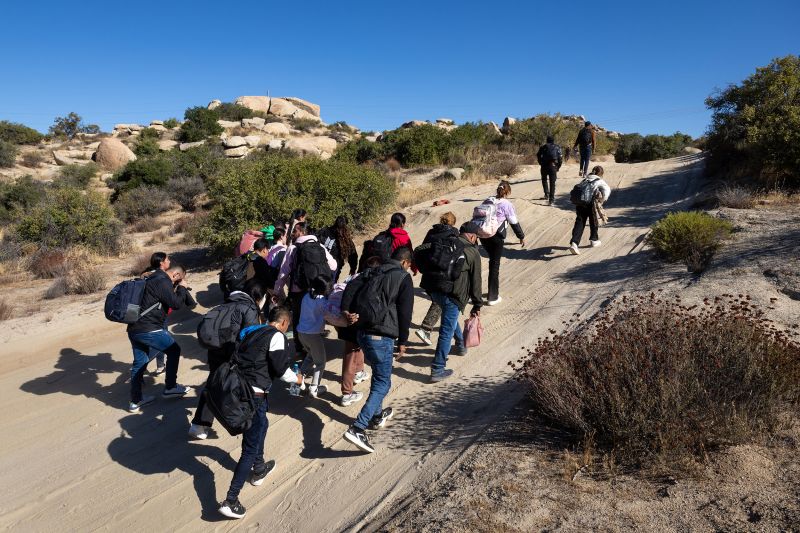Extreme weather is contributing to undocumented migration and return between Mexico and the United States, suggesting that more migrants could risk their lives crossing the border as climate change fuels droughts, storms and other hardships, according to a new study.
People from agricultural areas in Mexico were more likely to cross the border illegally after droughts and were less likely to return to their original communities when extreme weather continued, according to research this week in the journal Proceedings of the National Academy of Sciences.
Across the globe, climate change — caused by burning fossil fuels such as coal and natural gas — is exacerbating extreme weather. Droughts are longer and drier, heat is deadlier and storms are rapidly intensifying and dumping record-breaking rain.
In Mexico, a country of nearly 130 million people, drought has drained reservoirs dry, created severe water shortages and drastically reduced corn production, threatening livelihoods.
Researchers said Mexico is a notable country for studying the links between migration, return and weather stressors. Its mean annual temperature is projected to increase up to 3 degrees Celsius (5.4 degrees Fahrenheit) by 2060, and extreme weather is likely to economically devastate rural communities dependent on rain-fed agriculture. The US and Mexico also have the largest international migration flow in the world.
Scientists predict migration will grow as the planet gets hotter. Over the next 30 years, 143 million people worldwide are likely to be uprooted by rising seas, drought, searing temperatures and other climate catastrophes, according to a UN Intergovernmental Panel on Climate Change report.
The new migration research comes as Republican Donald Trump was reelected to the US presidency this week. Trump has called climate change a “hoax” and promised mass deportations of an estimated 11 million people in the U.S. illegally.
Researchers said their findings highlight how extreme weather drives migration.
Filiz Garip, a study researcher and professor of sociology and international affairs at Princeton University, said advanced nations have contributed far more to climate change than developing countries that are bearing the brunt.
Migration “is not a decision that people take up lightly … and yet they’re being forced to make it more, and they’re being forced to stay longer in the United States” as a result of weather extremes, Garip said.
The researchers analyzed daily weather data along with survey responses from 48,313 people between 1992 and 2018, focusing on about 3,700 individuals who crossed the border without documents for the first time.
They looked at 84 agricultural communities in Mexico where growing corn was dependent on weather. They correlated a person’s decision to migrate and then return with abnormal changes in temperature and rainfall in their origin communities during the May-to-August corn growing season.
The study found communities experiencing drought had higher migration rates compared to communities with normal rainfall. And people were less likely to return to Mexico from the US when their communities were unusually dry or wet. That was true for recent US arrivals and people who had been there longer.
People who were better off financially were also more likely to migrate. So were people from communities with established migration histories where friends, neighbors or family members who previously migrated could offer information and help.
These social and economic factors that influence migration are well understood, but Garip said the study’s findings underscore the inequities of climate adaptation. With extreme weather events, not everybody is impacted or responds in the same way, she said, “and the typical social and economic advantages or disadvantages also shape how people experience these events.”
For Kerilyn Schewel, codirector of Duke University’s Program on Climate, Resilience and Mobility, the economic factors highlight that some of most vulnerable people aren’t those displaced by climate extremes, but are rather “trapped in place or lacking the resources to move.”
Schewel, who was not involved in the study, said analyzing regions with migration histories could help predict where migrants will come from and who is likelier to migrate because of climate shocks. In “places where people are already leaving, where there’s a high degree of migration prevalence, … that’s where we can expect more people to leave in the future,” she said.
The survey data used from the Mexican Migration Project makes this study unique, according to Hélène Benveniste, a professor in Stanford University’s department of environmental social sciences. Migration data of its scale that’s community specific is “rarely available,” she said in an email. So is information about a person’s full migration journey, including their return.
The finding that return migration decisions were delayed by weather stress in origin communities is “important and novel,” said Benveniste, who studies climate-related human migration and was not involved in the study. “Few datasets enable an analysis of this question.”
But increased surveillance and enforcement along the US-Mexico border make returning home — and moving back and forth — more difficult, said Michael Méndez, assistant professor of environmental policy and planning at the University of California, Irvine. And once undocumented migrants are in the US, they often live in dilapidated housing, lack health care or work in industries such as construction or agriculture that make them vulnerable to other climate impacts, he said. Méndez was not involved in the study.
As climate change threatens social, political and economic stability around the world, experts said the study highlights the need for global collaboration around migration and climate resilience.
“So much of our focus has been, in a way, on the border and securing the border,” said Schewel from Duke. “But we need much more attention to not only the reasons why people are leaving, but also the demand for immigrant workers within the US.”



























